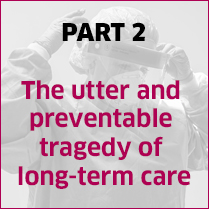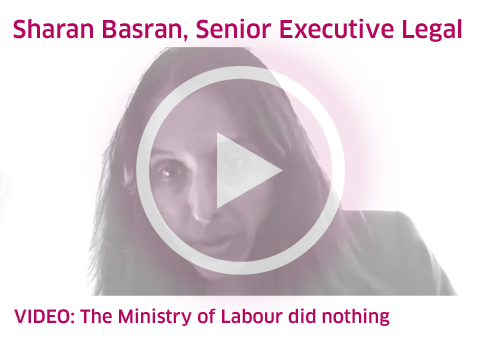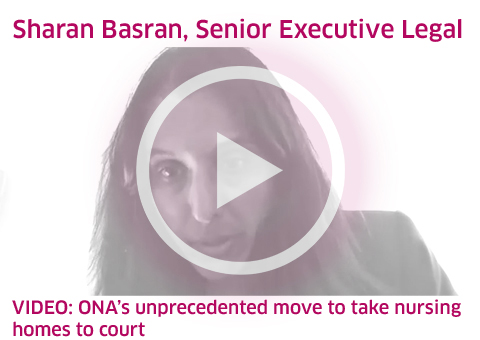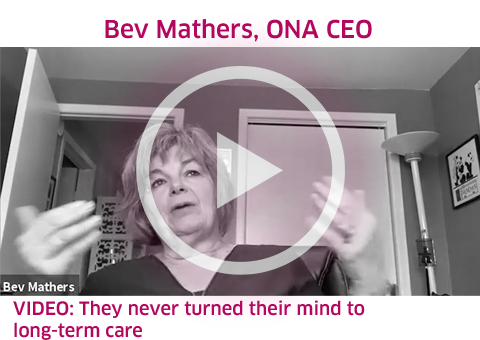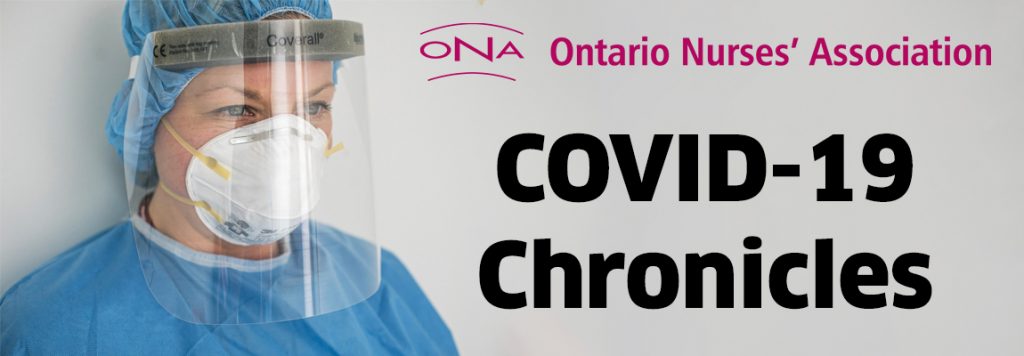
Could the tragedy in long-term care have been prevented?
Long-term care residents and nurses: each suffer devastating consequences from isolation
After months of isolation inside Ontario long-term care (LTC) homes, residents are experiencing severe and potentially irreversible cognitive, physical and mental health declines. This is likely due to the loneliness and depression that was fueled by the COVID-19 lockdowns.
“Our long-term care registered nurses and health-care professionals tried in vain day in and day out to help our residents as much as they possibly could,” says ONA First Vice-President Cathryn Hoy. “But some issues in the homes were too much to bear and overcome, including gross understaffing, which really hurt our residents.”
The impact of understaffing – registered nurses, registered practical nurses, nurse practitioners, personal support workers and health-care professionals – can best be described by ONA members. They provided hundreds of heartbreaking details in a survey that ONA launched late last year.
“It was a war zone. It was hell on the night shifts where I was alone with five or six actively dying people,” reported one ONA member. “I had 70 others who were sick. There was so much more to do but I just couldn’t.”
Some members felt abandoned: “We were bagging bodies. Doctors, pharmacists, coroners, funeral homes – they were not coming into the home. It was just the people who were there from day one. We were the only ones. We were abandoned.”
A feeling of helplessness became apparent in our members’ experiences, too: “I have never felt more helpless. There were too many residents dying and I couldn’t help them all.”
Residents spoke about loneliness
Harrowing stories abound of frail seniors confined to their rooms, alone, with no contact with their families and friends. Staff were frantically working off their feet, desperately trying to provide care and comfort.
Several LTC residents spoke about their experiences in testimony to the Long-Term Care COVID-19 Commission. One resident said he lost 20 pounds after “mental and physical isolation” robbed him of his appetite. Another resident noted, “I’ve been in lockdown for a very, very long time and it is depressing when you eat in your room, you sleep in your room. It’s very depressing.”
The personal and professional intersections
When speaking about long-term care, Hoy pauses for a long moment, and then shares her own personal long-term care story related to COVID-19 and isolation.
Her mother was living in a long-term care facility in eastern Ontario during the pandemic. One morning last summer, Hoy received a call from the home. “Early-morning phone calls are the worst, and you know something is terribly wrong,” she says, and was told to come to the home. Hoy spent her mother’s final days with her from inside her long-term care home.
Because of COVID-19, Hoy was unable to visit her mom for the majority of 2020, up until her passing. The stark reality of isolation took its toll on both Hoy and her mother, denying them additional quality time to spend with one another.
“I lost five months with my mom, and I understood it, but I wonder whether we really needed to suffer that loss,” Hoy explains. “I saw the care that was provided to my mom, and they did a great job, but I also witnessed how hard the nurses and health-care professionals worked and how they were run off their feet, and they gave it 200 per cent the entire time.”
LTC not ready
ONA’s President Vicki McKenna points to a lack of preparedness in long-term care as the pandemic unfolded. “We were hearing reports about high COVID-19 rates in nursing homes in March and April of last year, and we asked the government time and again, ‘Is long-term care ready? Is there enough staffing in place? And are infection prevention and control (IPAC) procedures being implemented?’ And I can say we were all deeply concerned about the lack of response from the Ford government.”
ONA CEO Bev Mathers agrees. “Long-term care has been broken for years. It is grossly understaffed; the homes are old and the for-profits are waiting for government money to redevelop them. What should have happened immediately is people needed to be screened before entering. Screen and stop. And they were too late in long-term care, and COVID got into the homes and the residents were like sitting ducks…the minute COVID spread in those facilities, it spread like wildfire.”
The disastrous reports from our front-line LTC members continued. “We discovered that most nursing homes were not prepared,” says Sharan Basran, Senior Executive, Legal. “There was no PPE, or it was locked up and inaccessible. IPAC measures were not put in place, and residents were not being isolated and cohorted appropriately, which is basic IPAC procedure. A curtain between two residents in the same room is not going to prevent transmission.”
Lack of PPE in homes
Early on in the pandemic, front-line members working in LTC raised many concerns regarding the lack of appropriate PPE available to them. Multiple reports surfaced that PPE – including N95 respirators – were locked up in cabinets/offices, making them inaccessible to workers. Some workers’ requests for N95 respirators were ignored, met with resistance or denied.
“I would request an N95 respirator, and I was either ignored or bullied and berated by the management team. I witnessed so many staff crying about this issue that it became a ‘part of my day.’ When nurses came from other facilities to help, they wore appropriate PPE. One of the RNs attempted to secure equipment for me, but her home facility refused,” wrote an ONA member in the survey.
It got to the point where ONA had no choice but to intervene to ensure members – and therefore residents – were protected.
“We knocked on every possible door to get a resolution,” notes Basran. ONA contacted the Ministry of Labour and inspectors conducted inspections over the phone. But no orders were issued.
“We told them nurses are being denied N95s, which are locked up. Nurses had to run around; COVID was spreading in the homes; and despite all of this, the Ministry of Labour did nothing,” says Basran. “We wrote local Medical Officers of Health and, despite clear evidence, they did nothing. We wrote to nursing homes representatives and requested expedited arbitration and they said they wouldn’t participate.”
Frustrated and angry at the complete lack of action, ONA took several nursing homes to court. The virus was spreading exponentially, and our members and their residents were becoming ill in alarmingly high numbers.
“We took the extraordinary step to go to court to protect not only staff but residents,” explains Basran. “And we won. It is a magnificent victory, but in another way, the expertise of registered nurses was not listened to from the get-go.”
It is very baffling to Hoy that nursing homes resisted giving appropriate PPE to workers. “Why were they denied? To save a few dollars? I cannot come up with any other reason. Why would any employer put anyone’s life at risk, knowing that PPE was imperative? One of the most valuable resources employers have is not the bottom line, it is the staff,” she says.
Adds Mathers, “We filed for an injunction in the nursing homes, and – in what world does a union file an injunction to say that our workers aren’t safe and the residents aren’t safe? – that is really where we had to go.”
ONA arbitration award serves as a blueprint for nursing homes
Following the court injunction, the nursing homes had a change of heart and agreed to arbitration. In the award, ONA dealt comprehensively with a range of infection control and occupational health and safety measures.
Through the collective work of ONA and its members, a program was developed that outlined what nursing homes should have in place: an effective Joint Health and Safety Committee, active residence surveillance, timely communication regarding COVID-19 cases, protocols around nurses being off due to exposures or a diagnosis, return-to-work protocols, access to fitted N95 respirators, and isolation and cohorting procedures.
“We empowered registered nurses and health-care professionals to make crucial decisions about the level of PPE they required at the bedside,” says Hoy. “This was a huge award that served as a blueprint in nursing homes that identifies the essential components needed to be in place for residents and registered nurses.”
Differences between British Columbia and Ontario
When the pandemic hit, British Columbia was first off the mark regarding health-care system preparedness. The provincial government and health authorities developed proactive policies for health-care workers.
“On the west coast, they made sure that everyone was paid the same regardless of whether you were working in a hospital or a nursing home,” Mathers points out. “This allowed workers to not hesitate in choosing their workplaces. And, if people wanted full-time hours, they got full-time hours. This did not happen in Ontario.”
ONA consistently raised the issue of people having to work in several health-care settings due to the piecemeal approach of predominantly casual and part-time work that is common in this sector. ONA urged the government and workplaces to offer full-time hours to workers, but this did not happen consistently. “We cannot have people working all over the place. We have people working casual and part time to cobble together enough hours to pay for their rent,” explains McKenna. “We implored the government and employers to offer full-time hours to workers, but that did not happen consistently.”
Self-isolation due to exposure
Nurses and health-care professionals continue to be routinely exposed to confirmed and suspected cases of COVID-19. Unfortunately, when there is an exposure, employers failed to ensure employee’s pay was kept whole during periods that they needed to self-isolate. When part-time and casual nurses and health-care professionals get sick with COVID-19, they don’t have access to paid sick days.
“No nurse or health-care professional should have to experience personal economic hardship for caring for their residents,” says Hoy. “We have been fighting this issue since the beginning and continue to push it. Compensation should be covered if workers are forced to self-isolate due to an exposure – it should be automatic.”
Basran agrees. “I think sometimes it is important to fight the good fight and this is a case in point. We fought the issue of failure to pay for self-isolation, and we were not successful. However, we have set the stage that we need to correct this, and it is a gap that we as a society must fill. It is clearly wrong, and if nurses are preventing the spread of COVID-19 in the workplace at the sacrifice of supporting their families, we as a society, have a moral and ethical obligation to support them and ensure that they have income continuation. This fight is not over.”
Many challenges continue
Despite ONA’s continued work in long-term care, many challenges remain. Chronic understaffing is now worse than ever, and recruitment is extremely difficult.
“We continue to see employers deny nurses access to N95 respirators; we continue to see residents not being cohorted; and we continue to witness problems related to basic infection control procedures,” notes McKenna. “We are one year into the pandemic, and I cannot believe we are still fighting these very basic safety issues with employers.”
ONA continues to hold employers accountable and invoke legal proceedings to enforce the rights of its members.
ONA’s advocacy at the Long-Term Care COVID-19 Commission
While this past year in Ontario’s long-term care sector has been devastating, ONA is hopeful that the tragedy in LTC and the government’s Long-Term Care COVID-19 Commission’s work will be the turning point for positive change for all.
The facts are crystal clear. More than 3,800 residents in long-term care have died due to COVID-19. Hundreds of ONA members working in long-term care became ill. Eleven dedicated workers have died, including one of our own members, Brian Beattie, RN.
The pandemic has been an unprecedented experience for ONA’s long-term care members. Whether it was sounding the alarm on health and safety deficits or infection prevention and control risks, demanding access to essential personal protective equipment, or addressing concerns regarding the directive to work for one single employer and fighting to keep our members’ pay whole, ONA has spent the last year ensuring LTC members were and continue to be heard and supported in this global challenge.
As a union that is firmly grounded in advocacy for our members and for patients, residents and clients, ONA set out to examine the circumstances surrounding the failures in the long-term care system. We heard first-hand from members, who recounted horrific and heartbreaking stories, their experiences unveiling deplorable conditions and situations. ONA produced detailed submissions and multiple reports for the Commission. A high-level executive summary outlines the main themes from ONA’s reports and offers next steps for changes needed in long-term care. All of ONA’s reports and submissions are on the website here.
Most importantly, in ONA’s submission to the Commission, we provide recommendations that — we continue to hope — will lead to the concrete changes that long-term care so desperately needs for the health and safety of our members and their residents.
After decades of advocating for change, through countless inquiries, commissions and hearings, ONA remains optimistic that the type of tragedy we have seen during the pandemic will never be allowed to happen again.
The dedicated registered nurses and health-care professionals who play a pivotal role in caring for our elderly must be protected so that they can be there for their residents. In turn, when they are protected, so are the residents.
“We have to remember that for people who are living in long-term care, this is their home, and very likely could be their last home,” says McKenna. “We need to do all that we can to ensure those who live there, have the very best experience and care possible. They deserve no less.”


